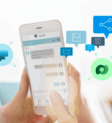Why The Future Of Chatbots is Low-Code

Gartner predicts, Low-code application building would gather more than 65% of all app development functions by the year 2024.
The COVID-19 pandemic has disrupted the entire business landscape and compelled businesses to face never-seen-before challenges and develop new workflows. Moreover, an increasing focus on the digitization of the industry drove up the demand for text and voice-based bots that automate day-to-day operations and deliver exceptional customer support.
With the IT department dealing with massive resource scarcity and struggling to develop apps for various business problems, enterprises started looking at smart solutions that allow people with little or no coding knowledge to quickly deploy AI-powered bots for a host of business use cases. No wonder many organizations turned to low-code app development platforms (LCAPs).
Low-code platforms are indeed the future of chatbot development. So, what’s a low-code app development platform? A low-code application platform, or an LCAP, is an interactive platform that leverages a visual interface, such as drag-and-drop tooling and pre-configured templates, to empower users to develop and deploy professional-grade bots within days.
Let’s explore further.
Benefits of building chatbots on a low-code platform
1. Infuses agility
The first and foremost advantage of low-code development is the agility that it allows in business operations because a) it’s quicker to build bots with pre-built modules and templates in a visual interface, b) employees, who are experts in their domains, can easily develop and refine their bots without the need to explain their ideas to others (coders). Research has shown low-code platforms can potentially reduce development time by up to 90%.
2. Reduces development costs
Hiring skilled developers proves heavier on the cost side. Low-code solutions require little or no coding knowledge, so professional and citizen developers alike can quickly build and deploy any app, making it economically viable to create intelligent chatbots for different business use cases, including service desk management, IT helpdesk, HR automation, etc.
3. Allows flexible integration
Low-code app development platforms allow integration with various SaaS-based and on-premise enterprise systems, helping organizations get a single-window view of their data.
4. Encourages innovation across functions and levels
Since low-code platforms enable domain/subject-matter experts to collaborate, develop, and customize their bots, they democratize innovation by not restricting it to a core team or group of individuals.
Seven low-code development tools for chatbots
1. Power Virtual Agents
Power Virtual Agents (PVA) is a Microsoft software-as-a-service (SaaS) offering in the low-code app development space. Microsoft’s Cloud services host the application; hence PVA significantly reduces the need for a conducive environment to deploy and maintain the bots.
Bot Framework and Azure Bot Service and Cognitive Services form the SDK to build chatbots using a guided, no-code visual interface, allowing citizen developers to build and deploy chatbots quickly. PVA greatly reduces the need to have the infrastructure to maintain and deploy chatbots as Microsoft’s Azure Cloud Services does all the heavy lifting of providing a conducive environment to host the application.
Read More: Power Virtual Agents & Power Automate – Truly Powerful!
2. Chatfuel
Chatfuel is a leading low-code chatbot development platform for Facebook Messenger. Chatfuel supports many languages and allows integration with several third-party apps.
Chatfuel’s built-in guides and predefined bot templates help create bots for automated customer support and sales and marketing activities easily. An analytics dashboard allows users to monitor and analyze several business and chatbot metrics.
3. FlowXO
FlowXO enables users to build both simple and complex AI bots and connect them to more than 100 different cloud apps. FlowXO provides a visual flow editor, supports multilingual chatbots, and allows integration with popular apps, such as Facebook and Slack. Other features include the ability to send emails and attachments and build chatbot widgets for websites.
4. Botsify
Botsify uses an easy-to-navigate drag-and-drop interface that enables users to build template designs for chatbots. Botsify’s chatbots are used by well-established companies, including Apple and Shazam.
The bots integrate with services, such as WordPress, Alexa, ZenDesk, Google Sheets, etc., and can collate user information, track sales leads, and automate sales chats.
5. BotKit
With a semantic chat interface, BotKit’s chatbots imitate human conversations. The platform boasts interesting features like a visual conversation builder and open source libraries.
Other features include activity monitoring, detailed statistics, and flexible API integrations.
6. TARS
TARS is another low-code bot-building platform that democratizes the process of building chatbots with pre-built templates that are easy to edit and customize.
Other exciting features of the platform include – integration with Zapier, file and image upload, custom branding, API integration, and the option to export data to Excel/CSV.
7. BotCore
At Acuvate, we help clients build and deploy AI-enabled chatbots quickly with our low-code enterprise bot-building platform called BotCore.
Fully deployable on Microsoft Cloud, BotCore’s graphical interface with drag-and-drop functionality, pre-built templates, and an integrated Knowledge Graph consisting of multi-functional nodes enable professional and citizen developers alike to create and deploy chatbots in a matter of days.
Some of the powerful features of BotCore include –
- BotCore leverages Message Definition Language (MDL) to define bot responses
- Technologies like natural language processing (NLP), natural language understanding (NLU), and machine learning enable our bots to understand the context, learn from past conversations, and respond to users in a human-like manner.
- Seamless agent handover capability allows bots to handle simple requests while escalating the more complex ones to human agents when needed.
- BotCore will enable clients to build multilingual bots that can be deployed across various channels, giving users a seamless omnichannel experience.
- Our bots can aggregate the best of Microsoft technologies, including LUIS bots, Power Virtual Agents, QnA Maker bots, and other third-party bot applications.
To know more about BotCore, feel free to schedule a personalized consultation with our chatbot experts.
Abhishek is the AI & Automation Practice Head at Acuvate and brings with him 17+ years of strong expertise across the Microsoft stack. He has consulted with clients globally to provide solutions on technologies such as Cognitive Services, Azure, RPA, SharePoint & Office 365. He has worked with clients across multiple industry domains including Retail & FMCG, Government, BFSI, Manufacturing and Telecom.






Abhishek Shanbhag